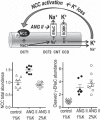Cardiovascular benefits associated with higher dietary K+ vs. lower dietary Na+: evidence from population and mechanistic studies
- PMID: 28174181
- PMCID: PMC5406991
- DOI: 10.1152/ajpendo.00453.2016
Cardiovascular benefits associated with higher dietary K+ vs. lower dietary Na+: evidence from population and mechanistic studies
Abstract
The World Health Organization ranks hypertension the leading global risk factor for disease, specifically, cardiovascular disease. Blood pressure (BP) is higher in Westernized populations consuming Na+-rich processed foods than in isolated societies consuming K+-rich natural foods. Evidence suggests that lowering dietary Na+ is particularly beneficial in hypertensive individuals who consume a high-Na+ diet. Nonetheless, numerous population studies demonstrate a relationship between higher dietary K+, estimated from urinary excretion or dietary recall, and lower BP, regardless of Na+ intake. Interventional studies with K+ supplementation suggest that it provides a direct benefit; K+ may also be a marker for other beneficial components of a "natural" diet. Recent studies in rodent models indicate mechanisms for the K+ benefit: the distal tubule Na+-Cl- cotransporter (NCC) controls Na+ delivery downstream to the collecting duct, where Na+ reabsorbed by epithelial Na+ channels drives K+ secretion and excretion through K+ channels in the same region. High dietary K+ provokes a decrease in NCC activity to drive more K+ secretion (and Na+ excretion, analogous to the actions of a thiazide diuretic) whether Na+ intake is high or low; low dietary K+ provokes an increase in NCC activity and Na+ retention, also independent of dietary Na+ Together, the findings suggest that public health efforts directed toward increasing consumption of K+-rich natural foods would reduce BP and, thus, cardiovascular and kidney disease.
Keywords: ENaC; NCC; dietary potassium; dietary sodium; hypertension.
Copyright © 2017 the American Physiological Society.
Figures


Similar articles
-
Potassium Supplementation Prevents Sodium Chloride Cotransporter Stimulation During Angiotensin II Hypertension.Hypertension. 2016 Oct;68(4):904-12. doi: 10.1161/HYPERTENSIONAHA.116.07389. Epub 2016 Sep 6. Hypertension. 2016. PMID: 27600183 Free PMC article.
-
Dissociation of sodium-chloride cotransporter expression and blood pressure during chronic high dietary potassium supplementation.JCI Insight. 2023 Mar 8;8(5):e156437. doi: 10.1172/jci.insight.156437. JCI Insight. 2023. PMID: 36719746 Free PMC article.
-
Dietary potassium and magnesium supplementation in cyclosporine-induced hypertension and nephrotoxicity.Kidney Int. 2000 Dec;58(6):2462-72. doi: 10.1046/j.1523-1755.2000.00429.x. Kidney Int. 2000. PMID: 11115079
-
Dietary potassium and the renal control of salt balance and blood pressure.Pflugers Arch. 2015 Mar;467(3):513-30. doi: 10.1007/s00424-014-1673-1. Epub 2015 Jan 6. Pflugers Arch. 2015. PMID: 25559844 Review.
-
Maintaining K+ balance on the low-Na+, high-K+ diet.Am J Physiol Renal Physiol. 2016 Apr 1;310(7):F581-F595. doi: 10.1152/ajprenal.00330.2015. Epub 2016 Jan 6. Am J Physiol Renal Physiol. 2016. PMID: 26739887 Free PMC article. Review.
Cited by
-
Pathophysiology and genetics of salt-sensitive hypertension.Front Physiol. 2022 Sep 13;13:1001434. doi: 10.3389/fphys.2022.1001434. eCollection 2022. Front Physiol. 2022. PMID: 36176775 Free PMC article. Review.
-
Potassium-Alkali-Enriched Diet, Hypertension, and Proteinuria following Uninephrectomy.J Am Soc Nephrol. 2024 Oct 1;35(10):1330-1350. doi: 10.1681/ASN.0000000000000420. Epub 2024 Jun 24. J Am Soc Nephrol. 2024. PMID: 38913441
-
Urinary Albumin, Sodium, and Potassium and Cardiovascular Outcomes in the UK Biobank: Observational and Mendelian Randomization Analyses.Hypertension. 2020 Mar;75(3):714-722. doi: 10.1161/HYPERTENSIONAHA.119.14028. Epub 2020 Feb 3. Hypertension. 2020. PMID: 32008434 Free PMC article.
-
The Differential Modulatory Effects of Potassium Supplementation on Blood Pressure, Vascular Reactivity, Glomerular Filtration Rates, and Oxidative Stress in Different Experimental Hypertensive Models.Nutrients. 2025 May 29;17(11):1865. doi: 10.3390/nu17111865. Nutrients. 2025. PMID: 40507134 Free PMC article.
-
Effects of water-immersion cooling temperatures on the moisture retention of sodium-reduced pork sausages.J Food Sci Technol. 2020 Jul;57(7):2516-2523. doi: 10.1007/s13197-020-04287-8. Epub 2020 Feb 5. J Food Sci Technol. 2020. PMID: 32549602 Free PMC article.
References
Publication types
MeSH terms
Substances
Grants and funding
LinkOut - more resources
Full Text Sources
Other Literature Sources
Medical

